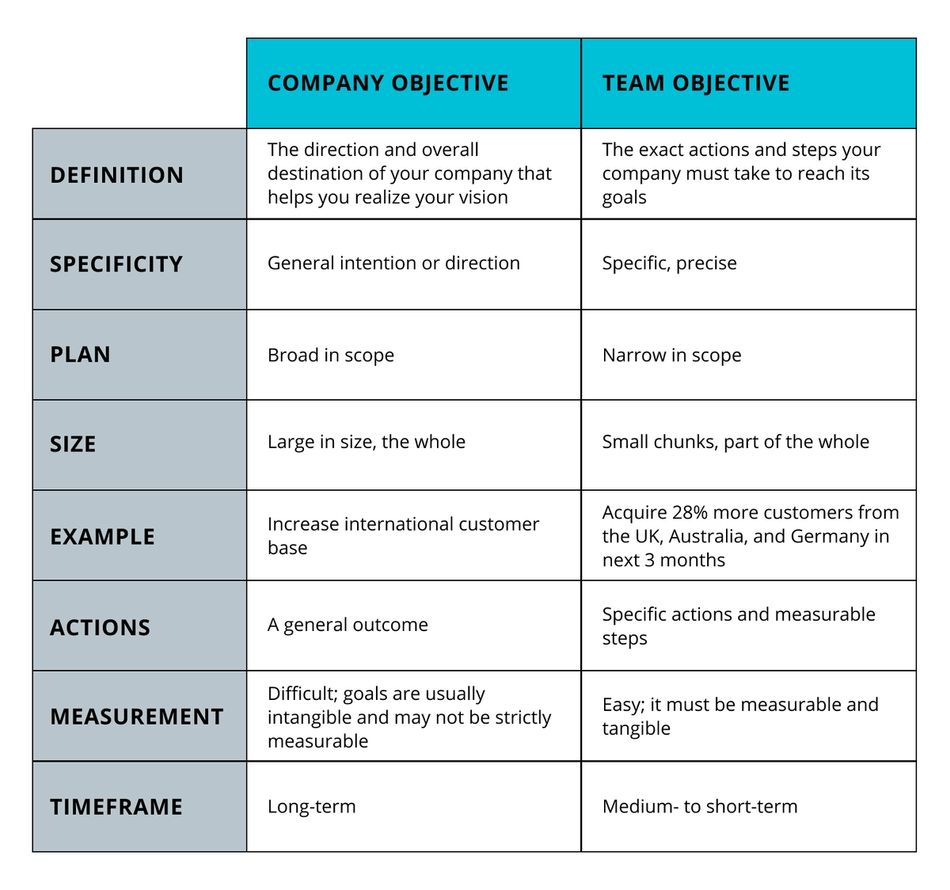Defining, aligning, and writing team objectives can be daunting. Often, company objectives (sometimes referred to as goals) are general; e.g. “gain more customers.” While they inform team goals and desired results, people often struggle with exactly what information to include.
Clear objectives are specific. They include a set time frame, they're measurable, and they have a direct impact on your organization.
A lot of organizations use the SMART criteria and goal setting method to define and measure objectives. Many of us here at Range use it, and we thought it would be helpful to share the method and provide clear examples to help you overcome vagueness in your company communication.
What are objectives?
“An objective is what we want to do” is how a former colleague simply put it. And that definition often matches company goals. But supporting objectives need to be defined in more detail.
So it's often helpful to think of objectives in two categories:
- A company objective sets the overarching direction for your business plan and define where you want to be in the future.
- Team objectives are the specific actions and measurable steps your company must take to reach a desired outcome. They give you a clear understanding of the specific tasks or projects that need to be completed in order to get closer to the company objective.
In other words, a company-level objective describes where your company wants to be in the future, but unlike team objectives, it doesn’t explain how you plan to get there.

Company-level objectives example
The right company level objectives (or, goals) will align with your company vision, purpose, business value, and long-term aspirations. For example, you might use company objectives in your yearly and quarterly company strategy, your positioning, mission statement, company culture guide, financial projections, and other crucial business documents and initiatives. Here are a few more specific examples that leaders might set as organizational objectives:
- Increase international customer base
- Foster a more inclusive company culture
- Improve cross-team communication
- Build trust between cross-functional departments
While these are worthy objectives, there are no specific time frames or actions that guide you on how to reach your destination. What defines an “inclusive company culture?” What are the particular tasks you need to complete? How would you know you've reached the goal?
This is where team objectives come in. In order for company-level goals to become actionable and achievable, they need to be broken down into team objectives and key results.

Leadership tip: Take business goals and needs into account when making decisions. “Balancing [technical curiosity] against the needs of the business and being able to make good well-reasoned decisions with some sense of urgency and some sense of where the business is headed and the goals” you’re trying to achieve are important to keep in mind.
For more on this tip, watch our Lead Time Chat with Chris Bee, CTO at Lessen.
Team-level objectives examples
Here's an example of how you can break down a company-level objective into measurable team objectives:
- Company objective: Increase international customer base
- Regional objective: Acquire 28% more customers from the UK, Australia, and Germany, in the next three months
- Outbound sales team objective: Reach out to 20 additional international prospects per week
- Product department team objective: Translate the onboarding flow and reduce the time for onboarding from 12 days to five days for all international customers in the next three months
- Marketing department team objective: Reduce cost-per-click from $2.50 to $0.50 for international digital ad campaigns and increase the reach from 100 to 500 people per week
Connect the dots between objectives and daily work
With Range, you can easily set objectives and make daily progress visible without micromanaging your team.
What are SMART objectives and how to write them
Objective has the word “object” in it. Objects are concrete. Because of this, objectives can be scoped with time frames, budgets, and tangible results. The SMART approach to developing objectives is a useful framework to help you make sure you've defined them in the right way.
The SMART acronym stands for:
- Specific — SMART objectives have a high level of concreteness with real metrics and deadlines that need to be tracked. For example, “Generate 50 leads from the UK before 30 Oct” is more specific than “increase the international customer base.”
- Measurable — Measure what matters. Make sure that you can track your objective. What's the key result — the measurable goal — that you're going to track?
- Attainable — Objectives are challenging but possible. “Helping 10 million international businesses be more productive” is an admirable goal but not an achievable goal if you have 100 customers. Don't try to conquer the world overnight.
- Relevant — Is the objective related to your long-term goal, and does it align with your company vision? Creating relevant goals is a must.
- Time-bound — Your objective needs to have a concrete deadline, which creates time constraints and a sense of urgency. “Someday” is not a day of the week.
From here, you can also set an individual objective underneath each, and then connect them to your personal action plan.
How to align your objectives in practice
At Range, we use our own goals feature in tandem with daily Check-ins to define, align, track, and report on our objectives.
With Goals in Range, you can:
- Create accountability by sharing information and updates across the team
- Easily track how daily work connects to your higher-level company goals
- Set a goal for metrics, team objectives, and KPIs
- With hashtags, see all artifacts, updates, and day-to-day progress in one place
- Share goal updates with leaders via Slack or email

We set company- and team-level objectives by quarter, review them in weekly meetings, and log work with quick daily check-ins, so everyone has insight into how projects are progressing. Range works with communication and project management tools like Slack, Asana, Trello, GitHub, and more, so it's easy to connect our tasks, documents, and code changes to our objectives.
Combined with the SMART approach, this level of transparency and collaboration helps us (and other teams who use Range) crystallize not only what matters, but also the daily steps we need to take to get closer to our desired destination.








